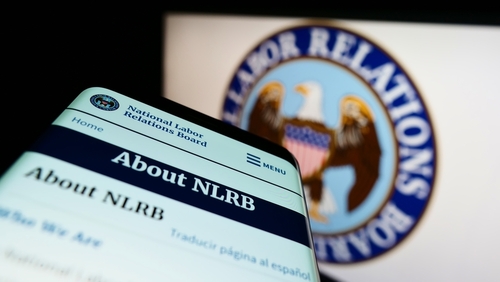Valuing and selling a firm takes time, matchmaker skills

Illustration by Stephen Webster
“Generally, for a lawyer who decides he or she is going to sell, the process starts with being careful to reveal just enough information to pique a prospective buyer’s interest in learning more about you and your business,” says Ed Poll, a lawyer who has been helping other lawyers sell and buy firms since 1990. He is the author of Selling Your Law Practice: The Profitable Exit Strategy.
Wisconsin lawyer David J. Herrick, for example, is seeking an eligible buyer.
“I’m looking to retire,” says Herrick, who has been practicing more than 30 years in rural Niagara. “I have my own building and office in it. File cabinets, desks, chairs. I know the building and office could be used for many commercial applications. I have the option of listing it with a Realtor. But I’m the only lawyer for our tricounty area. I’d really like to see another lawyer who’s a good fit to take over what I did.”
What Herrick did was build his practice from the ground up. “I graduated from the University of South Dakota, but I was born and raised in Waukesha [west of Milwaukee]. When I graduated, I knew I wanted to come back to Wisconsin. I studied for the bar, passed and always knew I wanted a rural area, so I came here and started my own practice.”
Herrick understands the daunting nature of starting a practice out of law school in general, but also in this economic environment. “Of course, a problem today for so many young lawyers is that so many are graduating with significant debt, which can make financing a firm difficult,” says Herrick.
“When you’re a young attorney like I was coming to an area that didn’t have any attorneys, you try to get the blessing of the mayor and the city council. I was a member of the American Legion, and you participate—get to know people. That’s the way to get the word out about you and what you do,” he says.
Getting the word out is what Herrick is trying to do now. “I’ve let my clients know I’m looking toward retirement.” But the buyer eligibility pool can be shallow for lawyers looking to sell because of the rules governing the sale.
“A lawyer’s fiduciary duties play a big part in who a firm can be sold to,” says Dennis A. Rendleman, ethics counsel for the ABA’s Center for Professional Responsibility. “And that means a seller can obviously only look at buyers who are lawyers with the appropriate education, bar admission and skills to take over a seller’s clients and cases.
ABA Model Rule 1.17: Sale of a Law Practice
A lawyer or a law firm may sell or purchase a law practice, or an area of law practice, including goodwill, if the following conditions are satisfied:
(a) The seller ceases to engage in the private practice of law, or in the area of practice that has been sold, [in the geographic area] [in the jurisdiction] (a jurisdiction may elect either version) in which the practice has been conducted;
(b) The entire practice, or the entire area of practice, is sold to one or more lawyers or law firms;
(c) The seller gives written notice to each of the seller’s clients regarding:
(1) the proposed sale,
(2) the client’s right to retain other counsel or to take possession of the file,
(3) and the fact that the client’s consent to the transfer of the client’s files will be presumed if the client does not take any action or does not otherwise object within 90 days of receipt of the notice. If a client cannot be given notice, the representation of that client may be transferred to the purchaser only upon entry of an order so authorizing by a court having jurisdiction. The seller may disclose to the court in camera information relating to the representation only to the extent necessary to obtain an order authorizing the transfer of a file.
(d) The fees charged clients shall not be increased by reason of the sale.
“However, a seller should first learn whether the state where you practice has adopted Rule 1.17 of the ABA’s Model Rules of Professional Conduct, titled Sale of a Law Practice. Most states have adopted the rule, which allows for the sale of an entire firm or just a particular area of practice, though some states have variations.”
The center provides an online comparison (PDF) of the applicable state laws adopting Rule 1.17. (For more on Rule 1.17, see “Set Sale.”)
Familiar with Wisconsin’s adoption of Rule 1.17, Herrick dipped his toes in the pool by posting the following ad in the Wisconsin Bar Journal: “I placed the ad with the Journal because the ideal situation for me is that I’d like to find someone who is admitted in Wisconsin, wants a rural practice, and is capable of handling real estate law, probate matters and some litigation,” he says. “I’d stay on for about six months on a part-time basis. … I’m willing to mentor to make sure that the transition is a good one, and then the goal would be that I’d have the new lawyer take over the practice.”
Herrick understands that his ad appeals to specific tastes. “I’ve enjoyed it, but a rural area isn’t what many lawyers want,” he says. “We’ll see who responds to the ad.”
But not all lawyers may find themselves in circumstances in which publicizing their intentions is in their best interests.
“I deal with lawyers who are in all kinds of circumstances, and especially those when discretion is needed,” Poll says. “It’s still a business, and sometimes it doesn’t pay to advertise that you’re wanting to close your doors.”
Indeed, sellers in more lawyer-populated areas where the experienced-lawyer demand outweighs the client supply may find that instead of eligible buyer nibbles, their selling intentions may tee up staff or clients as potential targets for poaching competitors. That’s one reason Poll created an online attorney marketplace, LawBiz Registry.

Photo of David Herrick by Sara Stathas
SEEKING TO BUY
Jim Cunningham is a California lawyer who placed an ad on LawBiz looking to expand in the greater Sacramento area, Truckee-Incline Village and Ventura County. “I would be completely open to talking to an attorney who says I want to retire in 18 months,” says Cunningham, an estate planner of more than 20 years.Cunningham’s firm has a presence in Southern and Northern California due to five acquisitions that expanded his practice.
“My first acquisition actually started out of necessity of helping someone else’s clients in 2003,” says Cunningham. “I ended up with a lawyer’s practice because I was working in an area where there was a lawyer who had died without a succession plan. I ended up hiring his wife, taking control of the files, and helping out the firm’s clients—who were people who would have been ships without rudders because the lawyer had not put a succession plan in place where another lawyer would be ready to step in.
“The second acquisition was from a lawyer who was leaving his practice to become a judge. Another acquisition was from an attorney who was moving to Colorado, and then 2013’s acquisition was from a well-regarded retiring California lawyer. She had made referrals to me during her career.
I knew what she did. She knew what I did. That acquisition of her firm—it just made good strategic sense since she was based in Auburn, and I moved into Northern California.”
In addition to Poll’s registry, bar ads and consultants, law school placement directors are another resource for potential buyers. But be prepared that after the initial attraction, the chemistry may not be there.
“Before you ever get to the conflict checking and due diligence phase, the seller and buyer have to talk,” says Poll. “They need to feel each other out, kind of like a first date.”
Indeed, Cunningham’s experience has been that not everyone he approaches is a match. “The ideal seller is going to have an existing client structure which doesn’t present conflicts, yet has business development opportunities for future work,” he says. “Those are the kind of factors for me as a buyer that are probably common to most buyers.”
Cunningham also takes into account a selling attorney’s personality and philosophy of work and clients. “Discussions may end because something is just off,” he says.

Photo of Ed Poll by Jonah Light
PREPARING FOR SALE
All practices have value. Maximizing value means making sure the financial house is in order. “From a seller’s perspective, there are things you should be doing before you decide to sell to maximize value—and keep doing once you decide to sell,” Poll says.
They include:
• Increase the profit margin. “Increasing billable hours is the obvious way to boost profits,” says Poll. Consider investing in technology designed to free up time for additional billable work.
• Diversify the revenue stream. “Diversification decreases adverse risk to your financial bottom line if a client leaves,” says Bill Brennan, the president of Brennan Strategy, a West Chester, Pennsylvania-based consultancy on law firm financial matters. He is a former principal of Altman Weil who has worked with Am Law 200 firms. Realization rates for accounts receivable are key. “Stay on top of collections,” adds Poll.
• Continue business development and branding practices. “The feedback a buyer receives when conducting due diligence should be that the seller is known as the ‘go to’ attorney for the seller’s practice area in that locale serviced,” Poll says.
• Streamline operations. “Good management sells,” says Poll. Low overhead, current and up-to-date data for clients, proper case management procedures: These are things that are attractive to an eligible buyer, according to both Brennan and Poll, and that can boost the seller’s asking price.

Photo of Bill Brennan by David Fonda
VALUING A PRACTICE
Fixed and intangible assets are the subjects of a valuation, though there is no one-size-fits-all method for measuring value to set a firm’s price, Brennan and Poll agree.
“Valuation is important, but it’s not necessarily a buyer’s deciding factor in whether a deal moves forward,” Brennan says. “For example, when a law firm is looking to buy because its partners want to add another specialty to their list of current practice areas and services, I’ve recommended against buyers doing valuations in the early stages. It wastes money and time during a phase when a prospective buyer should focus on whether a seller’s practice areas present synergies and minimal financial headaches in terms of conflicts clearances.”
Expect to hire a CPA or experienced consultant to assess the assets being sold. “Fixed assets—equipment, furniture—those are relatively easy to value,” says Dale Lash, partner-in-charge of RubinBrown’s Business Valuation Services Group in Denver. “Goodwill—that is the intangible asset that you’re really looking at because that is what a lawyer or professional services firm is transferring.” Goodwill is the combination of the lawyer’s knowledge, skill, judgment and reputation, he says. “That list shows you why goodwill itself is more difficult to measure than, say, a desk. Goodwill is unique to that individual or firm.”
How do you put a price on a lawyer’s reputation? An earnings multiplier is a common method for goodwill valuation; deriving it, however, is a subjective process. “Goodwill, if there is value in it, flows from the ability of the seller to successfully transfer a book of business to the buyer,” Lash says.
For the valuation experts to value goodwill, they evaluate the future income stream’s components. Those components calculate a number used for an earnings multiplier.
“Goodwill for a group in a professional services firm is valued differently than an individual practice,” says Lash. “The factors for evaluating the income and revenue streams differ.”
Brennan and Poll describe valuation as an art, not a science, because of the subjective factors. However, common factors for a solo practitioner’s earnings multiplier calculations include earnings history, geographic location, the practice’s marketing plan and the seller’s competition.
“Each practice is unique, just like each lawyer,” Poll says. “That being said, a general rule of thumb for a standardized multiple range is one-half to three times the gross revenues.”
Analyzing the subjective factors may increase or decrease the multiplier. “For example, assume the buyer can’t make the clients comfortable for some reason—that may result in a lower multiple. Ultimately, you want to know what kind of repeat business to expect a buyer to have.”
For small to medium-size firms, partner earnings and withdrawal rates are evaluated. “What’s important is to learn meaningful information about the firm, its lawyers, client base and operations,” Brennan says. “Questions such as: Are the nonretiring partners too dependent on the retiring partner? Is the region or practice struggling from a sluggish economy?” This information allows for benchmarks.
“Comparable-sized law firms may be researched when possible,” says Brennan. “Factors that go into measuring value include the ability of the lawyers to perpetuate business, the level of their name recognition, and their respective expertise in the specialties or practice areas.
“Take a founder and rainmaker of a 20-attorney firm, for example, who wants to retire. “That founder may explore selling and merging into a bigger firm, which could create value for the founder of the firm compared to seeing if, logically, the younger partners buy the retiring partner’s ownership interest. The underlying philosophy of valuing a practice goes back to doing what a seller can do to boost profitability,” Brennan says.

Photo of Jim Cunningham by Tony Avelar
DOING YOUR DUE DILIGENCE
Scrutinizing balance sheets and liabilities and determining the status of credit lines along with other types of debt is done during the financial analysis.
Potential buyer Cunningham says, “In addition to client relationships and future referrals that offer the future stream of income from them, I’m looking at business operations.”
The kind of infrastructure a seller offers becomes important. For example, an acquisition can bring additional costs for a buyer to integrate a seller’s technology (or lack of it) for operational management.
“I run an efficient business. Not all solo practitioners do,” says Cunningham. “I may want discounts to the price for inconsistencies or operational weaknesses that increase my acquisition costs.”
Anticipate scrutiny. “I recommend buyers review categories and amounts for expenses,” Brennan says. “Are there uncharacteristic expenses? Do high client entertainment expenses evidence a client relationship or indicate a problem? Is someone exceptionally profitable or unprofitable?”
Both seller and buyer should address professional liability concerns. “The professional standards for conflicts clearance and appropriate administrative records management procedures need to have been in place to avoid professional liability,” Poll says.
Sellers must verify that the buyer’s expertise, credentials and reputation are intact in order to minimize potential liability. “Inquire of the bar associations regarding disciplinary actions or complaints,” Poll advises. “Inquire about the availability of ‘tail’ insurance coverage,” as well.

Photo of Dale Lash by McCrory James
WAITING THE MANDATED TIME
At a minimum, a seller and buyer should plan for 90 or more days before consummating a sale. Professionals say that from start to finish, a law firm sale could take as long as 12 to 24 months.
“It depends on the condition of the seller’s practice, and sometimes even the seller’s condition—say, if the seller is a solo whose health is the reason for the sale,” Poll says. “A sale can’t happen overnight because the rules dictate a time period for client notification about the deal.
“Generally, the attorney selling has to obtain the consent of the client to transfer the file or, depending on the state’s law, not receive an objection from the client to the notification during the rule’s prescribed time limit that gives a client time to object to turning over the client’s file,” Poll says. “If it turns out a client doesn’t want the file information turned over to the buyer, the confidentiality rules prohibit the disclosure. Not waiting for your state law’s time period for consent to expire can get a seller into real trouble.”
Also ABA Model Rule 1.16(c) provides that a lawyer must comply with applicable law requiring notice or permission of a tribunal when terminating a representation.
“In practice, that means you may have a timing issue for the settlement or closing,” says Poll. “A lawyer who is selling a litigation practice, for example, should be prepared for the possibility that he or she may not be able to withdraw from the representation. If a jury has already been empaneled, that could be a situation where the seller couldn’t withdraw, so you couldn’t have a closing date until after the trial.”
Buyers looking to expand into new markets present additional opportunities for a seller, but also time delays. “Take an out-of-town buyer that has sufficient kinds of clients and work that the seller does so that the buyer has the abilities and capacities to take on the seller’s practice with few conflicts. Strategically, scale-wise, sometimes that buyer may need to spread out the costs of the acquisition within its existing operations,” Brennan says. “Planning and structuring that takes time.”
Cunningham says of his experience that even an arm’s-length transaction takes time. “Take the due diligence I did with retiring lawyer Ann Armstrong.
Our process, from start to finish, was about seven months. I had already known her, and she knew something about my practice to know that I was a good fit for what she needed for her clients. I knew she had about six staff [members]. But I still had to sit down and review the client files for conflicts, and then sit down with her clients to meet them and learn what they needed. That was an organized firm with client information readily available.” Brennan, Cunningham and Poll concur that additional time should be anticipated for due diligence needs where outdated client data exists.

Photo of Dennis Rendleman by Wayne Slezak
MAKING TIME FOR CLIENTS
It is in the financial best interests of both the seller and buyer to allocate time to make the seller’s clients comfortable with the sale process. The number of clients a buyer can reasonably count on to stay represents the future income stream.
“Yet law firms are unique because, unlike other businesses, you can’t really tie down the client base such as with noncompete agreements as with other types of business sales and mergers,” Lash says. Neither the seller nor the buyer can force a client to stay if the client doesn’t want to.
The good news is that the rules encourage a seller’s continued involvement after signing the purchase agreement. “ABA Formal Opinion 468 addresses what a seller can do when facilitating a law firm sale done under Rule 1.17,” says Rendleman. “Basically, the opinion provides that a selling lawyer can assist the buyer in the transition period for a reasonable time after the official date of the sale, so long as there is no additional cost to the client.”
Poll and Brennan both say parties should expect transitioning to take time after they sign the sales agreement. “The parties to a sale need to understand that integration isn’t automatic for staff, operations and sometimes even clients,” Brennan says.
DOCUMENTING AND NEGOTIATING
The sale of a law practice involves documentation, due diligence and negotiations over price and payment structures.
“The sale of a law firm happens in a complicated market,” says Brennan. “Before you ever start negotiations, you want to make sure you’re identifying only serious targets and have accurate information about your options to achieve the best deal.”
Transactional lawyers will understand that an offering memorandum, letter of intent, nondisclosure agreement and (eventual) purchase agreement routinely document the sale process. “The firm’s legal structure, ownership, management, governance, along with client breakdown, go in the materials,” Brennan says.
The letter of intent specifies the buyer is buying the practice. “Ethically, a buyer cannot select individual cases or clients to purchase,” Poll says. After the letter of intent is signed, due diligence starts. And with it sellers should prepare for a buyer’s shifting perspective of scrutinizing inconsistencies to beef up negotiating power.
“Remember, the practice of law is personal,” says Poll. A seller reminiscing about building a practice with a buyer nitpicking over details brings emotionally charged negotiations. “Heated discussions between the buyer and seller could kill a deal that otherwise makes sense,” he adds. “Hiring an experienced professional for handling those negotiations may keep a deal from washing out.”
Deal structures vary for law firm transactions. “With the factors that go into sizing up firms as prospects, don’t assume that the sale structure that worked for one firm automatically works for another,” Brennan cautions. “After all, a person entering into an important business transaction without a lawyer is foolish. It makes sense that a lawyer without experienced representation when entering a transaction could experience the same fate.”
One common deal structure is an earn-out, which ties the purchase price to the amount of business done over a certain number of months post-sale, or a percentage of clients remaining with the practice determined as of a date post-sale.
Poll doesn’t favor earn-outs for retiring lawyers. “It doesn’t work for many sellers because if you’re retiring, you need to know with certainty how much money you’re going to have to live on.
“One thing I always do: The sell number is fixed. If you need flexibility, you can have a payment schedule that is flexible. But the seller needs to go to sleep at night knowing how much he can spend, and you can’t do that without the sell number being certain.” Also with a fixed price, the buyer’s sale terms can build in protections. “For example, if the seller’s health is an issue such that the seller’s presale performance doesn’t involve making clients comfortable during transition, that can result in a decrease of business for the buyer,” Poll says. “A buyer would want to make sure that there’s a term covering that precaution before closing.”
Cunningham says of the structures of his five acquisitions, “it really came down to the sellers’ particular circumstances and how I made that work with what I needed as a buyer. That dictated how the payment structures would be.”
SMOOTHING THE TRANSITION
Brennan says that “buyers should make sure a plan exists about what is going to be done to integrate the staff, the operations, the clients.” Given that Rule 1.17 requires all clients to be informed about the sale, Poll advocates face-to-face meetings and similar letters of introduction.
“The language used by the seller is obviously going to be specific to the practice area, but conveying a message of trust and confidence in the buyer’s skills and the seller’s value of the client relationships is the purpose,” Poll says.
From a buyer’s standpoint, the seller’s confidence level in the buyer’s ability to provide continuity of services is key. “We had a letter from the seller to the client explaining the situation: ‘I’m retiring; here’s the new attorney,’ ” says Cunningham. “There’s a 90-day limbo period in the rules, of course, where I waited. To give you an idea of how much time I put in transitioning the seller’s clients, last year I had about 700 meetings with the clients I took over from the retiring lawyer in Auburn. I’d do the whole review of the clients’ files, then meet and confirm with the clients of the seller whose files I’m taking over to walk through with them the existing estate plans that they currently have.
“In estate planning, we’ve had changes in the law; so you go over that they understand the changes, and it’s a long process of asking the same kind of questions you would as if someone new walked in the door for help. I’d recommend other buyers who want a smooth transition allow for time to do the same because the clients need to get to know you, and you need to know them—that is, if you’re expecting them to stay after the seller leaves.”
Another marker for the transaction timeline is when to buy or sell. “When a geographic legal market lacks a presence for a specialty that your firm has, expansion may be worthy of the partners’ consideration,” Brennan says. Likewise, Poll says, “when your practice area is hot, that’s obviously of greater value. If you’re contemplating retirement, you have to consider that while you may want to stay engaged in the practice of law, sometimes circumstances don’t allow you to do it. Your health or a loved one’s health issues can turn you from lawyer into caregiver.”
Procrastination is costly. “Nearly every week a lawyer in his 60s or 70s, wanting to sell and retire, calls me,” Poll says. “It’s usually the wife of the lawyer, I know, that is making that lawyer call me because she can’t get him to make a plan, and she sees what he doesn’t: He’s not immortal.
“My message is simple. Make a plan while you are able. Start the process early, the earlier the better.” That’s the best way to maximize value and be sure clients get uninterrupted service.
This article originally appeared in the March 2015 issue of the ABA Journal with this headline: “For Sale: LwFrm—GrtDeal: Valuing and selling a firm takes time, matchmaker skills.”
Sidebar
Buyer’s Due Diligence Checklist
The checklist below also coincides with a seller’s preparation to ensure documentation is organized for anticipated buyer review.
• Filed federal income tax returns for the previous three to five years.
• Payroll tax returns.
• Accounts receivable.
• Lines of credit or other debt agreements.
• Third-party/vendor agreements (equipment, leases, subscriptions).
• Professional liability insurance policy (and applications) with focus on prior acts and “tail” coverage terms.
• Staff/employee benefits.
• Staff/employee evaluations.
• Conflicts checks/clearance system.
• File management (open, pending, closed cataloging and storage of matters).
• Readily accessible policy manual or operations protocol for passwords of computer system.
• Up-to-date chart of all files for transitioning and closure.
• Updated information for contacts (employees, clients, vendors, suppliers, memberships).
• State bar’s client file retention rules.
Seller’s ‘Due Diligence of Buyer’ Checklist
• Researching buyer’s expertise and skill.
• Verification of bar admission, license and certifications (if applicable).
• Researching buyer’s reputation.
• Existence of any malpractice claims (professional liability insurance carrier, bar and court records, if applicable).
• Buyer’s philosophy toward practice of law.
• Buyer’s philosophy toward clients.
• Availability of “tail” insurance coverage.
Susan A. Berson, author of several finance and tax books for lawyers, is a partner with the Berson Law Group of Overland Park, Kansas.
Write a letter to the editor, share a story tip or update, or report an error.


